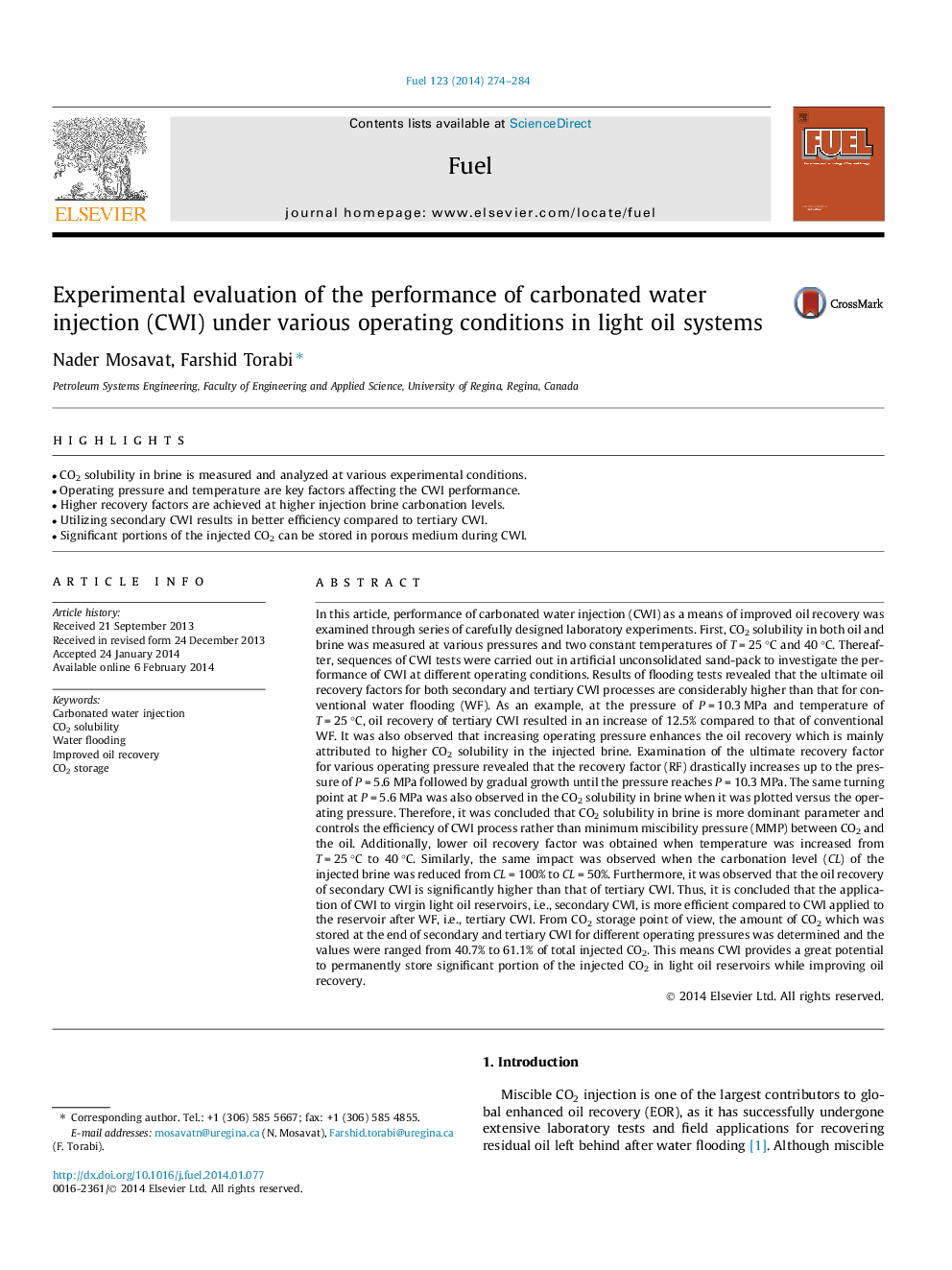| کد مقاله | کد نشریه | سال انتشار | مقاله انگلیسی | نسخه تمام متن |
|---|---|---|---|---|
| 6638088 | 461159 | 2014 | 11 صفحه PDF | دانلود رایگان |
عنوان انگلیسی مقاله ISI
Experimental evaluation of the performance of carbonated water injection (CWI) under various operating conditions in light oil systems
دانلود مقاله + سفارش ترجمه
دانلود مقاله ISI انگلیسی
رایگان برای ایرانیان
کلمات کلیدی
موضوعات مرتبط
مهندسی و علوم پایه
مهندسی شیمی
مهندسی شیمی (عمومی)
پیش نمایش صفحه اول مقاله

چکیده انگلیسی
In this article, performance of carbonated water injection (CWI) as a means of improved oil recovery was examined through series of carefully designed laboratory experiments. First, CO2 solubility in both oil and brine was measured at various pressures and two constant temperatures of T = 25 °C and 40 °C. Thereafter, sequences of CWI tests were carried out in artificial unconsolidated sand-pack to investigate the performance of CWI at different operating conditions. Results of flooding tests revealed that the ultimate oil recovery factors for both secondary and tertiary CWI processes are considerably higher than that for conventional water flooding (WF). As an example, at the pressure of P = 10.3 MPa and temperature of T = 25 °C, oil recovery of tertiary CWI resulted in an increase of 12.5% compared to that of conventional WF. It was also observed that increasing operating pressure enhances the oil recovery which is mainly attributed to higher CO2 solubility in the injected brine. Examination of the ultimate recovery factor for various operating pressure revealed that the recovery factor (RF) drastically increases up to the pressure of P = 5.6 MPa followed by gradual growth until the pressure reaches P = 10.3 MPa. The same turning point at P = 5.6 MPa was also observed in the CO2 solubility in brine when it was plotted versus the operating pressure. Therefore, it was concluded that CO2 solubility in brine is more dominant parameter and controls the efficiency of CWI process rather than minimum miscibility pressure (MMP) between CO2 and the oil. Additionally, lower oil recovery factor was obtained when temperature was increased from T = 25 °C to 40 °C. Similarly, the same impact was observed when the carbonation level (CL) of the injected brine was reduced from CL = 100% to CL = 50%. Furthermore, it was observed that the oil recovery of secondary CWI is significantly higher than that of tertiary CWI. Thus, it is concluded that the application of CWI to virgin light oil reservoirs, i.e., secondary CWI, is more efficient compared to CWI applied to the reservoir after WF, i.e., tertiary CWI. From CO2 storage point of view, the amount of CO2 which was stored at the end of secondary and tertiary CWI for different operating pressures was determined and the values were ranged from 40.7% to 61.1% of total injected CO2. This means CWI provides a great potential to permanently store significant portion of the injected CO2 in light oil reservoirs while improving oil recovery.
ناشر
Database: Elsevier - ScienceDirect (ساینس دایرکت)
Journal: Fuel - Volume 123, 1 May 2014, Pages 274-284
Journal: Fuel - Volume 123, 1 May 2014, Pages 274-284
نویسندگان
Nader Mosavat, Farshid Torabi,